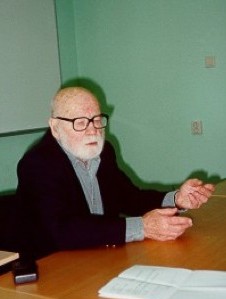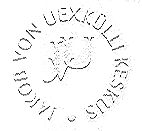Semiotics is the systematic study of sign processes and the communication of meaning. In semiotics, a sign is defined as anything that communicates intentional and unintentional meaning or feelings to the sign's interpreter.

Juri Lotman, a prominent Russian-Estonian literary scholar, semiotician, and historian of Russian culture, worked at the University of Tartu. He was elected a member of the British Academy (1977), the Norwegian Academy of Science and Letters (1987), the Royal Swedish Academy of Sciences (1989) and the Estonian Academy of Sciences (1990). He was a founder of the Tartu–Moscow Semiotic School. The number of his printed works exceeds 800 titles. His extensive archive includes his correspondence with a number of Russian and Western intellectuals.
Biosemiotics is a field of semiotics and biology that studies the prelinguistic meaning-making, biological interpretation processes, production of signs and codes and communication processes in the biological realm.
Zoosemiotics is the semiotic study of the use of signs among animals, more precisely the study of semiosis among animals, i.e. the study of how something comes to function as a sign to some animal. It is the study of animal forms of knowing.

Thomas Albert Sebeok was a Hungarian-born American polymath, semiotician, and linguist. As one of the founders of the biosemiotics field, he studied non-human and cross-species signaling and communication. He is also known for his work in the development of long-time nuclear waste warning messages, in which he worked with the Human Interference Task Force to create methods for keeping the inhabitants of Earth away from buried nuclear waste that will still be hazardous 10,000 or more years in the future.
The semiosphere is a concept in biosemiotic theory, according to which - contrary to ideas of nature determining sense and experience - the phenomenal world is a creative and logical structure of processes of semiosis where signs operate together to produce sense and experience.

Boris Andreevich Uspenskij is a Russian linguist, philologist, semiotician, historian of culture.

Kalevi Kull is a biosemiotics professor at the University of Tartu, Estonia.

John Deely was an American philosopher and semiotician. He was a professor of philosophy at Saint Vincent College and Seminary in Latrobe, Pennsylvania. Prior to this, he held the Rudman Chair of Graduate Philosophy at the Center for Thomistic Studies, located at the University of St. Thomas (Houston).
Phytosemiotics is a branch of biosemiotics that studies the sign processes in plants, or more broadly, the vegetative semiosis. Vegetative semiosis is a type of sign processes that occurs at cellular and tissue level, including cellular recognition, plant perception, plant signal transduction, intercellular communication, immunological processes, etc.
Giorgio Prodi was an Italian medical scientist, oncologist and semiotician.
The International Society for Biosemiotic Studies (ISBS) is an academic society for the researchers in semiotic biology. The Society was established in 2005. Its official journal is Biosemiotics, published by Springer and launched in 2008.
The Tartu–Moscow Semiotic School is a scientific school of thought in the field of semiotics that was formed in 1964 and led by Juri Lotman. Among the other members of this school were Boris Uspensky, Vyacheslav Ivanov, Vladimir Toporov, Mikhail Gasparov, Alexander Piatigorsky, Isaak I. Revzin, and others. As a result of their collective work, they established a theoretical framework around the semiotics of culture.

Jesper Hoffmeyer was a professor at the University of Copenhagen Institute of Biology, and a leading figure in the emerging field of biosemiotics. He was the president of the International Society for Biosemiotic Studies (ISBS) from 2005 to 2015, co-editor of the journal Biosemiotics and the Springer Book series in Biosemiotics. He authored the books Biosemiotics: An Examination into the Signs of Life and the Life of Signs and Signs of Meaning in the Universe and edited A Legacy for Living Systems: Gregory Bateson as Precursor to Biosemiotics.

Jakob von Uexküll Centre is an Estonia-based organisation for the work with the legacy of biologist, philosopher and semiotician Jakob von Uexküll. The Centre owns the major archive of his works in the world.
Ecosemiotics is a branch of semiotics in its intersection with human ecology, ecological anthropology and ecocriticism. It studies sign processes in culture, which relate to other living beings, communities, and landscapes. Ecosemiotics also deals with sign-mediated aspects of ecosystems.
The following outline is provided as an overview of and topical guide to semiotics:
Semiotics of culture is a research field within semiotics that attempts to define culture from semiotic perspective and as a type of human symbolic activity, creation of signs and a way of giving meaning to everything around. Therefore, here culture is understood as a system of symbols or meaningful signs. Because the main sign system is the linguistic system, the field is usually referred to as semiotics of culture and language. Under this field of study symbols are analyzed and categorized in certain class within the hierarchal system. With postmodernity, metanarratives are no longer as pervasive and thus categorizing these symbols in this postmodern age is more difficult and rather critical.
Copenhagen–Tartu school of biosemiotics is a loose network of scholars working within the discipline of biosemiotics at the University of Tartu and the University of Copenhagen.
Paul Cobley is an eminent British semiotician and narratologist.







